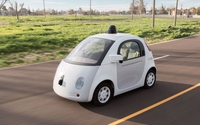 That’s a computer in the driver’s seat.
That’s a computer in the driver’s seat.
The
U.S. government has told Google that its system for piloting a self-driving car can be considered the actual driver of the car.
Google had asked the National Highway Traffic Safety
Administration (NHTSA) to interpret a number of provisions in the federal motor vehicle safety standards as they apply to Google’s design for motor vehicles that it’s developing and
testing.
Google stated that its self-driving car has “no need for a human driver.”
The NHTSA agreed, and stated that Google’s self-driving system “will not have
a driver in the traditional sense that vehicles have had drivers during the last more than 100 years.”
In a lengthy letter to Google, which reads like a government document, NHTSA
granted several of the requests by interpreting them against current safety regulations. Part of the letter states:
“No human occupant of the SDV
(self-driving vehicle) could meet the definition of driver, given Google’s described motor vehicle design, even if it were possible for a human occupant to determine the location of
Google’s steering control system, and sit immediately behind it, that human occupant would not be capable of actually driving the vehicle as described by Google.
“If no human occupant of the vehicle can actually drive the vehicle, it is more reasonable to identify the driver as whatever (as opposed
to whoever) is doing the driving. In this instance, an item of motor vehicle equipment, the SDS (self-driving system), is actually driving the vehicle.”
So
the way Google describes the vehicle, NHTSA does not see it as practical for a human to take over the actual driving of it.
To say there are challenging issues ahead, along with potential
legal liabilities, would be the understatement of the year.
And the Google requests to the NHTSA are complex.
For example, if a computer is determined to be the driver, Google says that
allowing human occupants to affect the operation of the vehicle, such as operating lamps or turn signals that otherwise would be controlled by the car system, could be detrimental to safety.
The computer-driven car also doesn’t technically need break or gas pedals, but they are part of current vehicle safety requirements.
Google is asking how NHTSA would rule on
certifying a car without conventional driver controls and interfaces, such as a steering wheel, gas pedal and turn signals.
And as an aside, I guess the vehicle won’t be referred to as a
driverless car, since a computer will officially be the driver.
And that driver won’t wear a seatbelt.
Wonder how they’ll get around that one!